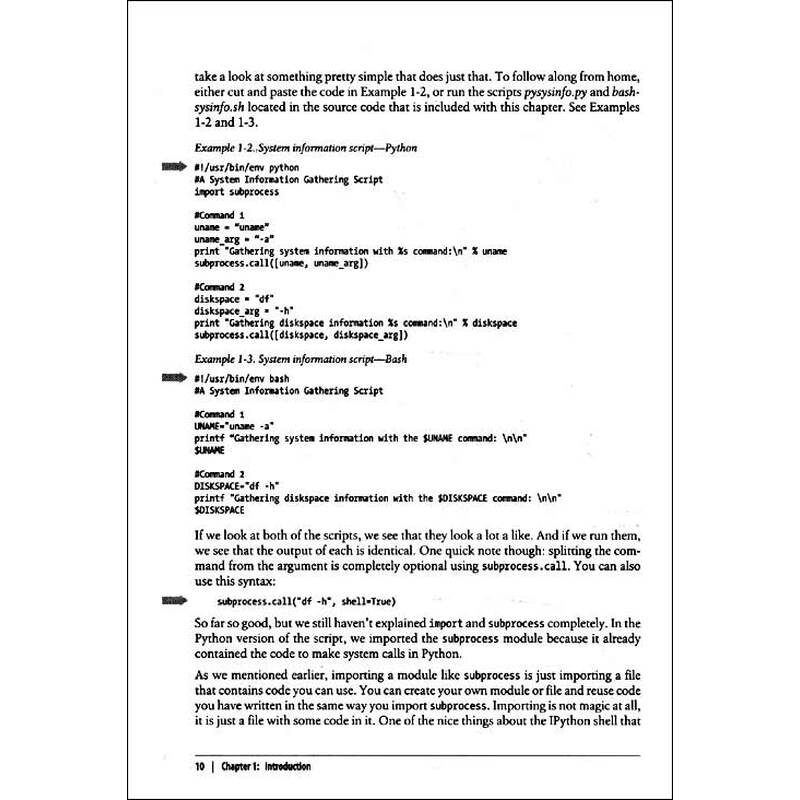书籍详情
![《Python在Unix和Linux系统管理中的应用》[21M]百度网盘|亲测有效|pdf下载](/uploads/s0309/014092e4-e13c-465f-82bd-0b3968e046b3.jpg)
![《Python在Unix和Linux系统管理中的应用》[21M]百度网盘|亲测有效|pdf下载](/uploads/s0309/014092e4-e13c-465f-82bd-0b3968e046b3.jpg)
Python在Unix和Linux系统管理中的应用
- 出版时间:2009-04
- 热度:10807
- 上架时间:2024-06-30 09:08:33
- 价格:0.0
书籍下载
书籍预览
免责声明
本站支持尊重有效期内的版权/著作权,所有的资源均来自于互联网网友分享或网盘资源,一旦发现资源涉及侵权,将立即删除。希望所有用户一同监督并反馈问题,如有侵权请联系站长或发送邮件到ebook666@outlook.com,本站将立马改正
内容介绍
内容简介
作者们还构建了一个可以免费下载的Ubuntu虚拟机。该虚拟机包含了这《Python在Unix和Linux系统管理中的应用(影印版)》的源代码,还可以用来运行书中的实例,包括SNMP、IPython、SQLAlchemy和许多其他工具。《Python在Unix和Linux系统管理中的应用》展示了Python语言如何提供一种更加高效的方式来处理Unix和Linux服务器管理工作中的各种任务。《Python在Unix和Linux系统管理中的应用(影印版)》的每一章都会提出一个特定的管理问题,例如并发或数据备份,然后通过实际的例子提供基于Python的解决方案。你将学习使用Python开发一套属于自己的命令行工具,并用来解决一系列范围很广的问题。通过《Python在Unix和Linux系统管理中的应用(影印版)》及其辅助虚拟机,你将学习如何打包并部署Python应用程序和库文件,以及如何编写在多个Unix和Linux平台下都运行良好的代码。
通过这《Python在Unix和Linux系统管理中的应用(影印版)》,你将发现Python是怎样帮助你:
·读入文本文件并提取信息
·使用线程和派生子进程的选项并发地运行多个任务
·使用网络工具从一个进程传送信息到另一个进程
·创建更易互动的可点击图形界面工具
·通过与SNMP交互来用程序监控大型多个集群机器
·掌握IPython的命令环境来替代或增强Bash、Korn或Z-Shell的功能
·将云计算集成到基础架构中并编写一个基于谷歌应用程序引擎的应用
·利用定制脚本来解决特殊的数据备份的挑战
·使用Django、SQLAlchemy和Storm对象关系模型来与数据库交互
通过这《Python在Unix和Linux系统管理中的应用(影印版)》,你将发现Python是怎样帮助你:
·读入文本文件并提取信息
·使用线程和派生子进程的选项并发地运行多个任务
·使用网络工具从一个进程传送信息到另一个进程
·创建更易互动的可点击图形界面工具
·通过与SNMP交互来用程序监控大型多个集群机器
·掌握IPython的命令环境来替代或增强Bash、Korn或Z-Shell的功能
·将云计算集成到基础架构中并编写一个基于谷歌应用程序引擎的应用
·利用定制脚本来解决特殊的数据备份的挑战
·使用Django、SQLAlchemy和Storm对象关系模型来与数据库交互
作者简介
Noah Gift在加州理工学院、迪斯尼、Feature Animation和Turner Studios具有十年以上的Unix和Linux开发经验。他是Giftcs和Cloud Seed软件公司的合伙人。
Jeremy M.Jones是Predictix公司的软件工程师,同时也是开源项目Munkware、ediplex和podgrabber的作者。
Jeremy M.Jones是Predictix公司的软件工程师,同时也是开源项目Munkware、ediplex和podgrabber的作者。
精彩书评
“这本书适用于Python新手,不管他们是否具有命令环境脚本编写的经验或者总体上相对而言就是编程初学者。Jeremy和Noah都很注意为自己的理由给出支持材料,并且解释这些代码实例在实际中的运用。与许多轻易就让新手不堪重负的编程书籍不同,本书尽一切努力来让这些新手们获得自信和成功。”
——Ruth Suehle和Bascha Harris,Red Hat杂志
——Ruth Suehle和Bascha Harris,Red Hat杂志
